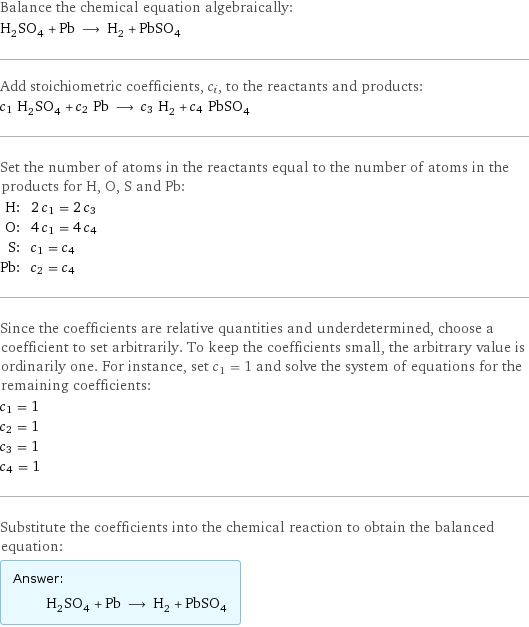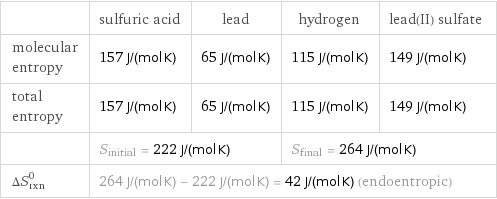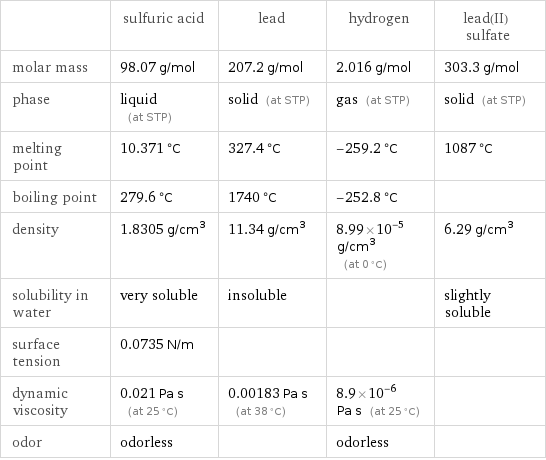Input interpretation

H_2SO_4 sulfuric acid + Pb lead ⟶ H_2 hydrogen + PbSO_4 lead(II) sulfate
Balanced equation

Balance the chemical equation algebraically: H_2SO_4 + Pb ⟶ H_2 + PbSO_4 Add stoichiometric coefficients, c_i, to the reactants and products: c_1 H_2SO_4 + c_2 Pb ⟶ c_3 H_2 + c_4 PbSO_4 Set the number of atoms in the reactants equal to the number of atoms in the products for H, O, S and Pb: H: | 2 c_1 = 2 c_3 O: | 4 c_1 = 4 c_4 S: | c_1 = c_4 Pb: | c_2 = c_4 Since the coefficients are relative quantities and underdetermined, choose a coefficient to set arbitrarily. To keep the coefficients small, the arbitrary value is ordinarily one. For instance, set c_1 = 1 and solve the system of equations for the remaining coefficients: c_1 = 1 c_2 = 1 c_3 = 1 c_4 = 1 Substitute the coefficients into the chemical reaction to obtain the balanced equation: Answer: | | H_2SO_4 + Pb ⟶ H_2 + PbSO_4
Structures

+ ⟶ +
Names

sulfuric acid + lead ⟶ hydrogen + lead(II) sulfate
Reaction thermodynamics
Enthalpy

| sulfuric acid | lead | hydrogen | lead(II) sulfate molecular enthalpy | -814 kJ/mol | 0 kJ/mol | 0 kJ/mol | -920 kJ/mol total enthalpy | -814 kJ/mol | 0 kJ/mol | 0 kJ/mol | -920 kJ/mol | H_initial = -814 kJ/mol | | H_final = -920 kJ/mol | ΔH_rxn^0 | -920 kJ/mol - -814 kJ/mol = -106 kJ/mol (exothermic) | | |
Entropy

| sulfuric acid | lead | hydrogen | lead(II) sulfate molecular entropy | 157 J/(mol K) | 65 J/(mol K) | 115 J/(mol K) | 149 J/(mol K) total entropy | 157 J/(mol K) | 65 J/(mol K) | 115 J/(mol K) | 149 J/(mol K) | S_initial = 222 J/(mol K) | | S_final = 264 J/(mol K) | ΔS_rxn^0 | 264 J/(mol K) - 222 J/(mol K) = 42 J/(mol K) (endoentropic) | | |
Equilibrium constant
![Construct the equilibrium constant, K, expression for: H_2SO_4 + Pb ⟶ H_2 + PbSO_4 Plan: • Balance the chemical equation. • Determine the stoichiometric numbers. • Assemble the activity expression for each chemical species. • Use the activity expressions to build the equilibrium constant expression. Write the balanced chemical equation: H_2SO_4 + Pb ⟶ H_2 + PbSO_4 Assign stoichiometric numbers, ν_i, using the stoichiometric coefficients, c_i, from the balanced chemical equation in the following manner: ν_i = -c_i for reactants and ν_i = c_i for products: chemical species | c_i | ν_i H_2SO_4 | 1 | -1 Pb | 1 | -1 H_2 | 1 | 1 PbSO_4 | 1 | 1 Assemble the activity expressions accounting for the state of matter and ν_i: chemical species | c_i | ν_i | activity expression H_2SO_4 | 1 | -1 | ([H2SO4])^(-1) Pb | 1 | -1 | ([Pb])^(-1) H_2 | 1 | 1 | [H2] PbSO_4 | 1 | 1 | [PbSO4] The equilibrium constant symbol in the concentration basis is: K_c Mulitply the activity expressions to arrive at the K_c expression: Answer: | | K_c = ([H2SO4])^(-1) ([Pb])^(-1) [H2] [PbSO4] = ([H2] [PbSO4])/([H2SO4] [Pb])](../image_source/2040fe341d545faa4c4ce59f53e71328.png)
Construct the equilibrium constant, K, expression for: H_2SO_4 + Pb ⟶ H_2 + PbSO_4 Plan: • Balance the chemical equation. • Determine the stoichiometric numbers. • Assemble the activity expression for each chemical species. • Use the activity expressions to build the equilibrium constant expression. Write the balanced chemical equation: H_2SO_4 + Pb ⟶ H_2 + PbSO_4 Assign stoichiometric numbers, ν_i, using the stoichiometric coefficients, c_i, from the balanced chemical equation in the following manner: ν_i = -c_i for reactants and ν_i = c_i for products: chemical species | c_i | ν_i H_2SO_4 | 1 | -1 Pb | 1 | -1 H_2 | 1 | 1 PbSO_4 | 1 | 1 Assemble the activity expressions accounting for the state of matter and ν_i: chemical species | c_i | ν_i | activity expression H_2SO_4 | 1 | -1 | ([H2SO4])^(-1) Pb | 1 | -1 | ([Pb])^(-1) H_2 | 1 | 1 | [H2] PbSO_4 | 1 | 1 | [PbSO4] The equilibrium constant symbol in the concentration basis is: K_c Mulitply the activity expressions to arrive at the K_c expression: Answer: | | K_c = ([H2SO4])^(-1) ([Pb])^(-1) [H2] [PbSO4] = ([H2] [PbSO4])/([H2SO4] [Pb])
Rate of reaction
![Construct the rate of reaction expression for: H_2SO_4 + Pb ⟶ H_2 + PbSO_4 Plan: • Balance the chemical equation. • Determine the stoichiometric numbers. • Assemble the rate term for each chemical species. • Write the rate of reaction expression. Write the balanced chemical equation: H_2SO_4 + Pb ⟶ H_2 + PbSO_4 Assign stoichiometric numbers, ν_i, using the stoichiometric coefficients, c_i, from the balanced chemical equation in the following manner: ν_i = -c_i for reactants and ν_i = c_i for products: chemical species | c_i | ν_i H_2SO_4 | 1 | -1 Pb | 1 | -1 H_2 | 1 | 1 PbSO_4 | 1 | 1 The rate term for each chemical species, B_i, is 1/ν_i(Δ[B_i])/(Δt) where [B_i] is the amount concentration and t is time: chemical species | c_i | ν_i | rate term H_2SO_4 | 1 | -1 | -(Δ[H2SO4])/(Δt) Pb | 1 | -1 | -(Δ[Pb])/(Δt) H_2 | 1 | 1 | (Δ[H2])/(Δt) PbSO_4 | 1 | 1 | (Δ[PbSO4])/(Δt) (for infinitesimal rate of change, replace Δ with d) Set the rate terms equal to each other to arrive at the rate expression: Answer: | | rate = -(Δ[H2SO4])/(Δt) = -(Δ[Pb])/(Δt) = (Δ[H2])/(Δt) = (Δ[PbSO4])/(Δt) (assuming constant volume and no accumulation of intermediates or side products)](../image_source/68ce0da5c939aefa6c33d5aa497841ff.png)
Construct the rate of reaction expression for: H_2SO_4 + Pb ⟶ H_2 + PbSO_4 Plan: • Balance the chemical equation. • Determine the stoichiometric numbers. • Assemble the rate term for each chemical species. • Write the rate of reaction expression. Write the balanced chemical equation: H_2SO_4 + Pb ⟶ H_2 + PbSO_4 Assign stoichiometric numbers, ν_i, using the stoichiometric coefficients, c_i, from the balanced chemical equation in the following manner: ν_i = -c_i for reactants and ν_i = c_i for products: chemical species | c_i | ν_i H_2SO_4 | 1 | -1 Pb | 1 | -1 H_2 | 1 | 1 PbSO_4 | 1 | 1 The rate term for each chemical species, B_i, is 1/ν_i(Δ[B_i])/(Δt) where [B_i] is the amount concentration and t is time: chemical species | c_i | ν_i | rate term H_2SO_4 | 1 | -1 | -(Δ[H2SO4])/(Δt) Pb | 1 | -1 | -(Δ[Pb])/(Δt) H_2 | 1 | 1 | (Δ[H2])/(Δt) PbSO_4 | 1 | 1 | (Δ[PbSO4])/(Δt) (for infinitesimal rate of change, replace Δ with d) Set the rate terms equal to each other to arrive at the rate expression: Answer: | | rate = -(Δ[H2SO4])/(Δt) = -(Δ[Pb])/(Δt) = (Δ[H2])/(Δt) = (Δ[PbSO4])/(Δt) (assuming constant volume and no accumulation of intermediates or side products)
Chemical names and formulas

| sulfuric acid | lead | hydrogen | lead(II) sulfate formula | H_2SO_4 | Pb | H_2 | PbSO_4 Hill formula | H_2O_4S | Pb | H_2 | O_4PbS name | sulfuric acid | lead | hydrogen | lead(II) sulfate IUPAC name | sulfuric acid | lead | molecular hydrogen |
Substance properties

| sulfuric acid | lead | hydrogen | lead(II) sulfate molar mass | 98.07 g/mol | 207.2 g/mol | 2.016 g/mol | 303.3 g/mol phase | liquid (at STP) | solid (at STP) | gas (at STP) | solid (at STP) melting point | 10.371 °C | 327.4 °C | -259.2 °C | 1087 °C boiling point | 279.6 °C | 1740 °C | -252.8 °C | density | 1.8305 g/cm^3 | 11.34 g/cm^3 | 8.99×10^-5 g/cm^3 (at 0 °C) | 6.29 g/cm^3 solubility in water | very soluble | insoluble | | slightly soluble surface tension | 0.0735 N/m | | | dynamic viscosity | 0.021 Pa s (at 25 °C) | 0.00183 Pa s (at 38 °C) | 8.9×10^-6 Pa s (at 25 °C) | odor | odorless | | odorless |
Units
